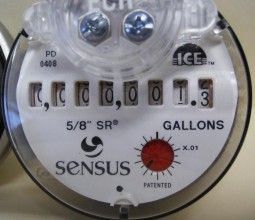Officials: Get used to paying more for less water
by Dave Roberts | November 24, 2015 8:53 am
 [1]Californians may need to get used to paying more for water, despite and because of their successful efforts at conservation, according to state water officials at a recent Assembly committee hearing.
[1]Californians may need to get used to paying more for water, despite and because of their successful efforts at conservation, according to state water officials at a recent Assembly committee hearing.
Californians exceeded the state’s 25 percent water conservation mandate in October for the fourth month in a row. That might be good news for a parched state, but it’s also drying up the coffers of many water districts, some of which have raised rates to help make up the loss.
Ratepayers are in essence being punished for obeying the state order to conserve water – something they thought would save them money. That has officials like John Laird, secretary of the California Natural Resources Agency[2], scrambling to explain.
“In some places people see costs go up, and think they conserved and did a great job, and yet the fixed costs are the same. And it is very confusing,” Laird acknowledged at a Nov. 17 hearing[3] by the Select Committee on Water Consumption and Alternative Resources[4].
“It flies in the face of the public’s general view that if you pay more you should get more, as opposed to you might have to pay more to get what you get now,” Laird continued. “As opposed to if the system collapses because there’s no investment you might have to pay more to get a lot less. And that is a very hard concept to explain to the rate-paying public in a way that they get it.”
Water and Power Departments’ Budgetary Woes
Los Angelenos have reduced water use by 18 percent, according to the Los Angeles Department of Water and Power[5], which has resulted in a $110.7 million hit to the agency’s budget. LADWP is now proposing a $57.6 million rate hike to recoup a little over half of its losses.
Other districts that have passed or are considering conservation-related rate hikes include the Contra Costa Water District, the East Bay Municipal Utility District and the San Diego Public Utilities Department, according to Reuters[6].
“It doesn’t seem intuitive that I’m using less water, but I’m paying more,” said Assemblyman Rich Gordon[7], D- Menlo Park, who chairs the committee. “How do you explain that to the public?”
Mark Cowin, director of the California Department of Water Resources[8] responded, “I would agree that getting this message across that we’re going to expect ratepayers, and taxpayers for that matter, to pay more to hopefully not lose more than they would have otherwise, it’s a tough message,”
He cited the proposed $15 billion Delta pipelines project, known as the California WaterFix[9], which is expected to be funded largely through rate hikes.
“Why would we expect water users in southern California, the Bay Area and the Central Valley to pay more to get the same amount of supply they are now?” said Cowin. “Well, we have to make the case that sustainability is worth the price we are asking people to pay for.”
Climate change can actually help state officials make that case to the public, he said.
Messaging to the Public
“I think we have as good an opportunity now as we ever have,” Cowin said. “We’re in this unique opportunity right now where we’re messaging to the public: keep conserving water because we might have a fifth year of drought, plus prepare for a potential Godzilla El Nino flood event. That really is what we are looking at as the new normal for California extremes.”
Cowin continued, “So we have got to be able to message better that global climate change leads to these extremes, [which] means that the typical inexpensive sources of water are a thing of the past. And more expensive options are a part of the future.
“We’ve been lucky for decades or generations that we’ve had relatively inexpensive water throughout California, some more expensive than others. But, moving forward, water is going to be more expensive and we’re going to have to pay for it.”
Increasing Water Use Efficiency
One way to keep costs down is to use water more efficiently. Currently, much of California’s treated wastewater ends up dumped in rivers and streams. California should follow Israel’s model and instead spread that treated effluent on farms and orchards, said Eilon Adar, a professor at Ben-Gurion University of the Negev[10], via Skype.
“Water is still being used in non-responsible ways,” he said. “You waste water. Cities in the Bay Area, they produce a lot of effluence that cannot be used in the Bay Area. However, if diverted about 150 miles to the south there are places in California that can appreciate this water.”
The state definitely can do more with recycled wastewater, said Peter Gleick[11], president of the Pacific Institute[12]. Only about 13 percent of California’s wastewater – 600,000 acre-feet – is currently recycled. He believes the state will meet its targets of annually producing 1 million acre-feet of recycled wastewater by 2020 and 2 million acre-feet by 2030.
“That’s an enormous amount of water,” Gleick said. “That’s water that we already have, that we already capture and treat and throw away into the ocean. Let’s put that to use.”
Gleick said he’s also concerned about “massive over-pumping of the groundwater. There’s been this long-term inexorable drop in groundwater. Groundwater is a resource, but we’re over-tapping it. And that’s unsustainable, and we know that that’s a problem.”
He continued, “There’s been enormous progress in capturing water use efficiently and developing local supplies. We are, however, still living beyond our means. We are taking too much water from our rivers and streams and especially in our aquifers. Even in wet years we over-pump our aquifers. That is unsustainable.”
 [13]On the plus side, nearly doubling the amount of groundwater pumping has helped the state’s $54 billion agricultural industry weather the drought, according to Jay Lund, director of the Center for Watershed Science at UC Davis[14]. About 70 percent of the lost surface water was made up by groundwater.
[13]On the plus side, nearly doubling the amount of groundwater pumping has helped the state’s $54 billion agricultural industry weather the drought, according to Jay Lund, director of the Center for Watershed Science at UC Davis[14]. About 70 percent of the lost surface water was made up by groundwater.
As a result, despite four years of drought, state agriculture has lost only about 4 percent in net revenue and about 10,000 jobs, he said.
“It’s amazing to have this drought with this relatively small effect,” Lund said. “We will always have drought in California. It’s like the East Coast having hurricanes.”
He agreed with Cowin that weather extremes like drought have the benefit of reminding the public about the state’s ongoing water needs.
“Droughts bring attention to where water management is not keeping pace,” said Lund. A Dutch engineer told him “in the Netherlands they need to have a threatening flood every generation to remind them that they have water problems. California is a dry place susceptible to floods. It’s useful for us … to see droughts and floods from time to time.”
The committee plans to hold a hearing in December in Los Angeles on desalination and one in January in Sacramento on recycling and reclamation issues.
- [Image]: http://calwatchdog.com/wp-content/uploads/2015/04/water-meter-2.jpg
- California Natural Resources Agency: http://resources.ca.gov/
- hearing: http://calchannel.granicus.com/MediaPlayer.php?view_id=7&clip_id=3244
- Select Committee on Water Consumption and Alternative Resources: http://assembly.ca.gov/waterconsumption
- Los Angeles Department of Water and Power: http://www.ladwpnews.com/go/doc/1475/2694762/
- Reuters: http://www.reuters.com/article/2015/10/24/california-drought-idUSL1N12O00H20151024#xUHE8KdWgwysErTf.97
- Assemblyman Rich Gordon: http://asmdc.org/members/a24/
- California Department of Water Resources: http://www.water.ca.gov/
- California WaterFix: http://www.californiawaterfix.com/
- Ben-Gurion University of the Negev: http://in.bgu.ac.il/en/Pages/default.aspx
- Peter Gleick: http://pacinst.org/about-us/staff-and-board/dr-peter-h-gleick/
- Pacific Institute: http://www.thepacificinstitute.com/
- [Image]: http://calwatchdog.com/wp-content/uploads/2015/04/Farm.jpg
- Center for Watershed Science at UC Davis: https://watershed.ucdavis.edu/
Source URL: https://calwatchdog.com/2015/11/24/officials-get-used-to-paying-more-for-less-water/